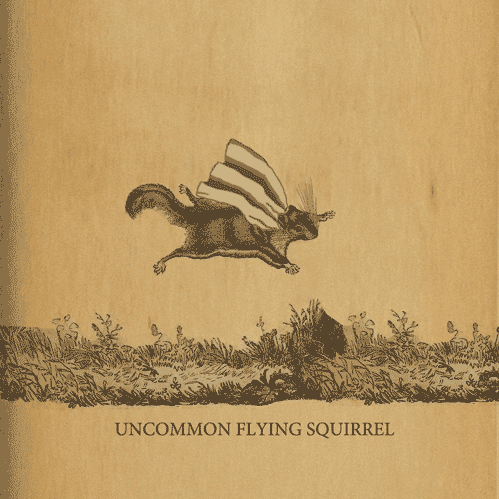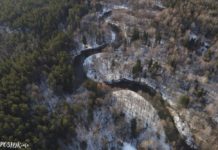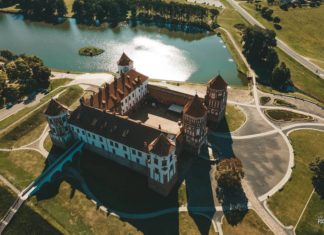Common flying squirrel in Belarus
Have you ever seen flying squirrel? This is such a pretty animal, similar to a squirrel, but with a flying membrane between the front and hind legs. The membrane acts as a parachute and helps to plan from tree to tree. Some hundred years ago common flying squirrel in Belarus could be found everywhere. However, over time, its habitat has significantly decreased, and since 1996, meetings with this animal have ceased to be recorded.

Description of the common flying squirrel
The Belarusian subspecies of the common flying squirrel is characterized by a rusty-yellow hue on the back and a long fluffy blackish tail with the same shade. The coat is soft and silky, shorter in summer than in winter. In length, an ordinary flying squirrel reaches up to 20,5 centimeters, and weighs about 205 grams.

Habitats in Belarus
In the 40s, encounters with flying squirrels were recorded in the Vitebsk and Mogilev regions. In 1960, it could also be found in the Gorodok, Vitebsk, Orsha, Polotsk and Rosson regions.
New traces of the habitat of a rare animal were discovered in 2016. During the expeditions 2017-2018, organized by the employees of the Brest branch of the public organization "Akhova bird Batskaushchyny" to search for rare species of flora and fauna, it was recorded 8 nesting sites flying squirrels in the Gorodok region. The new technique helped not only to find several habitats of a rare animal, but also to photograph it. In total, during the days of expeditions in the Gorodok and Vitebsk regions, about 30 habitats of this rare animal were identified.
Life activity and habitat of the common flying squirrel
The common flying squirrel chooses old-growth spruce-small-leaved forests with hollow trees, mainly in river and lake valleys, as a place to live.
The common flying squirrel leads an arboreal lifestyle and is active at night. Quickly moves through the trees, and if necessary, makes gliding flights sometimes up to 50 meters. In a calm state, the flying membrane is a soft lateral fold. Before the jump, the animal shrinks into a ball, pushes off the trunk and straightens sharply, stretching its front legs. With an open membrane, the squirrel's body doubles, and its silhouette in flight resembles a trapezoid. Before landing, the flying squirrel is in a vertical position, slows down with the help of membranes, sharply raising its tail, and descends on all paws on a tree 2 m from the surface.

When alarmed, the common flying squirrel purrs softly, and chirps loudly if it is strongly excited by something. When playing or eating, it whistles melodically and abruptly. Down the animal rarely descends, because due to clumsiness and slowness it can easily fall into the teeth of a predator.
The flying squirrel builds its nest in abandoned hollows, sometimes it occupies magpie and squirrel nests, as well as birdhouses and empty hives. She is very attached to her habitat, so for several years in a row she can choose the same hollow.
The flying squirrel does not hibernate as such, it just leaves the nest less often. In severe frosts, it briefly climbs out a couple of times a night. In the spring, during the mating period, the animal is active up to 11 hours a day, in the summer it is about 7-8. During the day, the flying squirrel sleeps, but she has a light sleep.
Common flying squirrels eat quite diversely: buds, young leaves and seeds, berries, nuts, mushrooms, and sometimes insects. In winter, the diet of animals includes staminate catkins, buds and shoots of birch, alder and aspen. Also, flying squirrels make provisions in their hollows.

All year long, flying squirrels live in pairs, breeding from April to July, and during this period they lose their caution so that they can be found during the day. Cubs are born after 35 days, naked and blind, but with well-defined flying membranes. On the 16th day, the eyes of the babies open, and at the age of 1 month they leave their homes in search of food.
In winter, young flying squirrels often stay in the same hollow with adults. If they are caught off guard on the ground, the animals cling to the ground, cowering and closing their eyes, in an attempt to merge with the earth floor. A mother desperately rushes to protect her children. There is a known case when the cubs were taken from the nest, the female boldly rushed at the kidnapper and pursued him for a long time.
Since the common flying squirrel is rather secretive and leads a nocturnal lifestyle, it has few natural enemies: tawny owl and marten. Food competitors for them are black grouse and hazel grouse, which also feed on catkins and buds of alder and birch in winter.
Under natural conditions, the flying squirrel lives 8-13 years.
Key Threats and Protection Measures
The main threat to the existence of the common flying squirrel is deforestation and the destruction of hollow trees. The common flying squirrel is listed in the Red Book Belarus since 1993 with the third category of protection. Now a more detailed study of animals is planned, the search for new habitats, after which it is necessary to create specialized micro-reserves with a ban on cutting down trees in them.
text: Ekaterina Golubnicchaya














